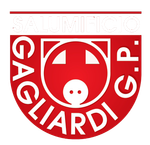Pancetta Piacentina D.O.P.
Denominazione Origine Protetta ai sensi del Reg. CE 1263/96 Certificato da Organismo di Controllo autorizzato dal Mipaaf
Protected Designation of Origin pursuant to EC Reg. 1263/96 Certified by Control Body authorised by Mipaaf
TYPICAL CURING TIME
3 months from salting date
ORGANOLEPTIC CHARACTERISTICS
Compact, non-elastic consistency. When cut, the slice must be compact and homogenous, bright red interspersed with the white of the fatty parts. Fragrance and flavour with a pleasant, sweet aroma and savoury bite.
USAGE
Remove the twine and skin, and slice. After cutting, we recommend storing it in the refrigerator.
Excellent as an appetiser, served on warm croutons or slices of toasted polenta.
RAW MATERIAL
For the production of Pancetta Piacentina, the central part of the half-carcase fat covering that goes from the retrosternal to the inguinal region is used, including only the lateral part of the udder. Pancetta represents one of the fatty cuts of the pig that is obtained by first isolating the so-called pancettone, which comprises several parts and from which the actual pancetta is obtained. After cutting, the piece is squared and trimmed. The transfer of the bacon to the processing plant must take place within the next 72 hours by refrigerated means.
PRODUCTION ZONE
Pig herds for the production of Pancetta Piacentina must be located in the regions of Lombardy and Emilia Romagna. Pigs born, reared and slaughtered in the above-mentioned regions must comply with the prescriptions already established at a national level for the raw material for Parma and San Daniele designation of origin hams. Breeding farms must comply with the aforementioned prescriptions as regards breeds, feeding and rearing methods. Pigs must weigh 160 kg, plus or minus 10%, and be not less than nine months old. Carcasses must have the characteristics defined according to Regulation (EC) No. 1234/2007 of 22/10/2007. The slaughterer is responsible for the qualitative and origin correspondence of the cuts. The slaughterhouse document, which accompanies each batch of raw material and certifies its origin and type, must be kept by the producer. It has a rather elongated cylindrical shape, is wrapped in its rind, sewn longitudinally, tied with elastic string, cut into slices and vacuum-packed.
MATERIA PRIMA
Per la produzione della Pancetta Piacentina si utilizza la parte centrale del grasso di copertura della mezzena che va dalla regione retrosternale a quella inguinale, comprendendo la sola parte laterale delle mammelle. La pancetta rappresenta uno dei tagli adiposi del suino che si ottiene isolando con apposita sezionatura dapprima il cosiddetto “pancettone” che comprende varie parti e da cui si ottiene la pancetta vera e propria. Dopo la sezionatura il pezzo viene squadrato e rifilato. Il trasferimento delle pancette allo stabilimento di trasformazione, deve avvenire entro le 72 ore successive con mezzi refrigerati.
Zona di produzione
Gli allevamenti dei suini destinati alla produzione della Pancetta Piacentina debbono essere situati del territorio delle Regioni Lombardia ed Emilia Romagna. I suini nati, allevati e macellati nelle suddette Regioni debbono essere conformi alle prescrizioni già stabilite a livello nazionale per la materia prima dei prosciutti a denominazione d’origine di Parma e San Daniele. Gli allevamenti devono infatti attenersi alle citate prescrizioni per quanto concerne razze, alimentazione e metodologia di allevamento. I suini debbono essere di peso di 160 kg, più o meno 10%, di età non inferiore ai nove mesi. Le carcasse devono avere le caratteristiche definite ai sensi Reg. (CE) n.1234/2007 del 22/10/2007. Il macellatore è responsabile della corrispondenza qualitativa e di origine dei tagli. Il documento del macello, che accompagna ciascuna partita di materia prima e ne attesta la provenienza e la tipologia, deve essere conservato dal produttore. Di forma cilindrica piuttosto allungata, si presenta avvolta nella sua cotenna, cucita longitudinalmente, legata con spago elastico, tagliata in tranci e confezionata sottovuoto.
TEMPO TIPICO DI STAGIONATURA
3 mesi dalla data di salatura
Caratteristiche organolettiche
Consistenza compatta non elastica. Al taglio la fetta si deve presentare compatta ed omogenea, di colore rosso vivo inframmezzato dal bianco delle parti grasse. Aroma e sapore dal profumo gradevole, dolce e di spore sapido.
UTILIZZO
Eliminare lo spago, scotennate ed affettare. Dopo il taglio si consiglia la conservazione in frigorifero.
Ottimo come antipasto, servito su crostini caldi o fette di polenta abbrustolita.
PRODUCTION PROCESS
The process consists of dry salting the well-trimmed bacon with a mixture of salt and spices. Salting lasts for 15 days, during which the bacon stays in refrigerated rooms. After being scraped, rolled and stitched, it is tied and transferred to drying rooms for 7 days, after which it is placed in curing rooms where it remains until it is fully "matured".
The product is then marketed after having undergone the operation of removing the harness, cutting and packaging in vacuum bags.





